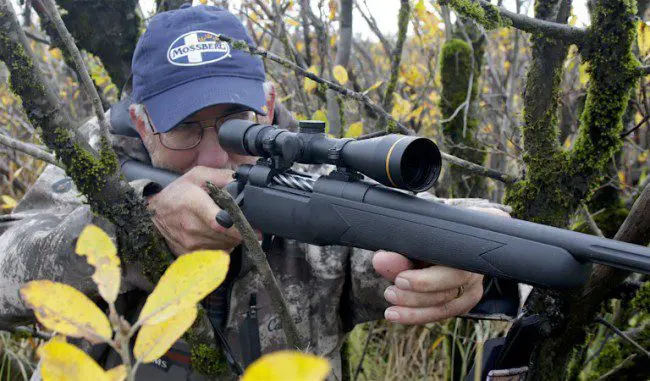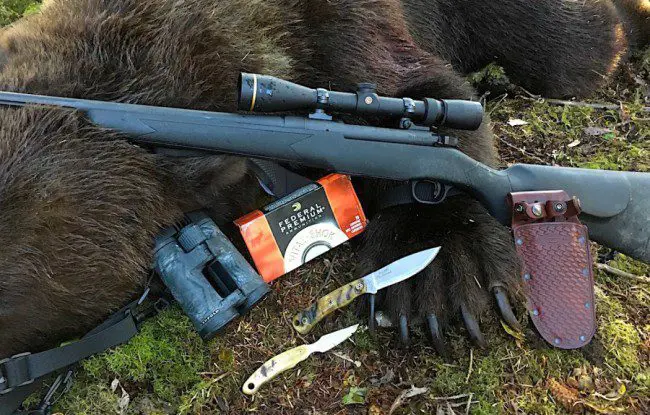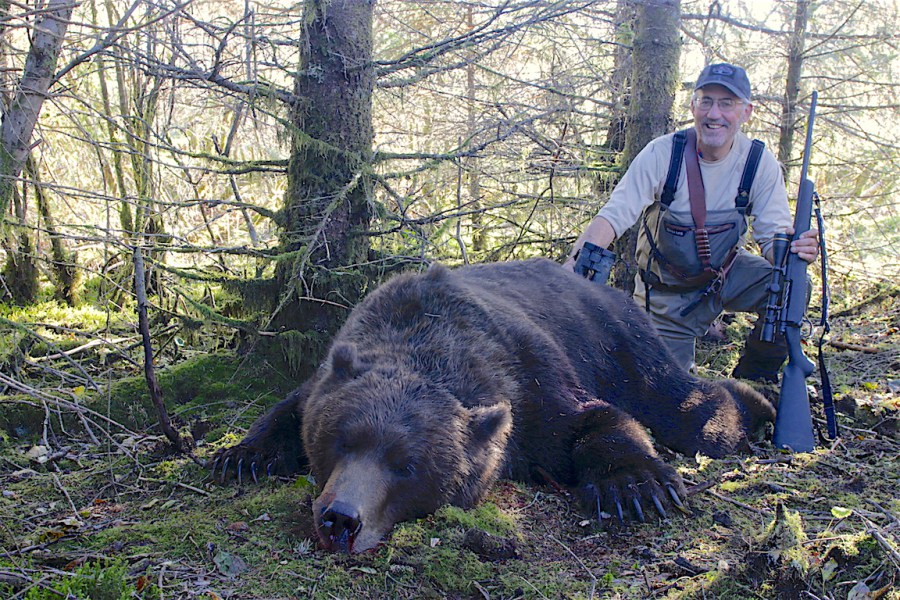A Mossberg Patriot v. a Brown Bear?
The Mossberg Patriot bolt action in this story sells for an MSRP of just $384. Would you risk hunting dangerous game with such an inexpensive rifle? Tom did.
Hunters have been wrestling with this question for decades, often taking aggressive positions for or against “cheap” guns. “Why would anyone pay more than $400 for a rifle?” versus “Why would anyone risk his life—or hunt—to a cheap rifle?”
Even without the threat of a charging bear or lion, many advocates of higher priced rifles don’t want to risk missing a shot at a good buck or bull because of a cheap rifle. The question is, how likely is an inexpensive rifle going to fail in comparison to an expensive rifle?

Tom dragged plenty of sandy water into the boat and onto his Mossberg lying on its floor. He kept his own hide dry under Simms Gore-Tex waders, the perfect pant for Alaska.
What’s Better, Expensive Rifle or Mossberg Patriot Price?
During half a century of hunting on six continents, I’ve suffered missed shooting opportunities with cheap rifles. But also expensive rifles. I cannot honestly say the higher priced versions always outperformed the lower priced ones. I’ve taken big, mature bull elk with a $400 Mossberg Patriot, a $1,200 Ruger Hawkeye, and a $3,500 New Ultra Light Arms custom; the elk never knew the difference. I’ve tested sub-$400 rifles that grouped sub-MOA and cycled through full magazines without a hitch, time after time. I’ve tested $3,000 rifles that jammed, failed to fire, and grouped 2-MOA.
Last fall my friend Tom Claycomb hunted brown bear (watch the video here) with Alaska Expedition Company in wind and rain and swamps and wet sand for a week with a Plain Jane, Mossberg Patriot in .338 Win. Mag. The action and barrel were blued. The stock was black molded plastic. There was no stainless steel, no epoxy bedded action, no aluminum bedding block, no aluminum bedding screw sleeves, no one-piece floorplate, no controlled round feed, and no three-position safety. MSRP for this rifle was just $384.
Tom is not the kind of guy to baby a rifle. He treats it worse than I treat a hammer. His Mossberg often lay in the bottom of a boat, sloshing in water. It got rained on nearly every day. Sand stuck to it.
To Tom’s credit, he did dry it off each night, and I think he might have run an Otis cable down the bore once or twice, even rubbed some oil over the exposed metal, but other than that . . . That Patriot took a beating and, to our delight, still fired. Tom sent a Federal Premium 250-grain Partition through both shoulders of his boar from about 150 yards out, racked in a follow-up round — but never got to fire it. A one-shot kill on a big brown bear with a $384 dollar rifle? Nary a hitch.

With a $384 Mossberg rifle, you might have enough money left to fit it with an equally rugged $400 Leupold VX3i 3.5-10×40 scope.
The Safety Net
Some would say “lucky!” And maybe so. That rifle could have failed in some way. The bear could have charged and wrapped the barrel around Tom’s neck or, worse, mine.
But let’s be realistic: How many of us hunt alone? Tom not only had me there with a Patriot chambered in .375 Ruger, but a much more experienced and effective backup shooter, Master Guide Charles Allen, with a proven, custom big bore chambered for the .411 KDF wildcat throwing 400-grain bullets. Allen had once used that rifle to stop a charge at 12 feet. Tom certainly didn’t walk alone.

Master Guide Charles Allen whipped out his personal Diamond Blade knives to skin Tom’s bear.
What Really Makes Rifles Expensive?
Let’s also be realistic about why some rifles are more expensive than others. Expense is often about things other than function. Fine walnut, fancy checkering, and polished finishes are just some of the things that boost price without impacting function. Don’t get me wrong, I love fancy, finely built, classic rifles. I even like hand-laid, stiff fiberglass stocks and stainless steel metal. But I can’t afford a closet full of them. Nor do I want to drag high-grade walnut rifles through the mess Tom dragged his Patriot through.
So, if and when you are considering an inexpensive versus expensive rifle, be sure you’re considering the right ingredients. Is it expensive because it’s more accurate, smoother functioning, and fail safe? Or because it includes expensive wood and detailed workmanship? I won’t criticize anyone who invests big bucks in a hunting rifle. I understand the incentive. But neither will I criticize anyone who buys a $400 rifle and saves the rest of his hard-earned cash for a better scope, rain jacket, or a few more hunts.
Mossberg Patriot: Flawless Function Is the Real Goal
The trick in every case is to make sure your rifle functions perfectly, flawlessly, reliably. Like Tom’s did. You might have to “work-in” an inexpensive rifle, test fire to discover its favorite ammo, maybe glass bed the action, polish the bolt and bore, or even add an inexpensive aftermarket stock like a laminate from Boyds Gunstocks in South Dakota. Good for you. The more you work with your rifle, the better it functions, the better you know it, and the more you respect it.
Beware the hunter with one rifle because he likely knows how to use it. Regardless how much he paid for it.
For more from Ron Spomer, check out his website, ronspomeroutdoors.com, and be sure to subscribe to Sporting Classics for his rifles column and features.

